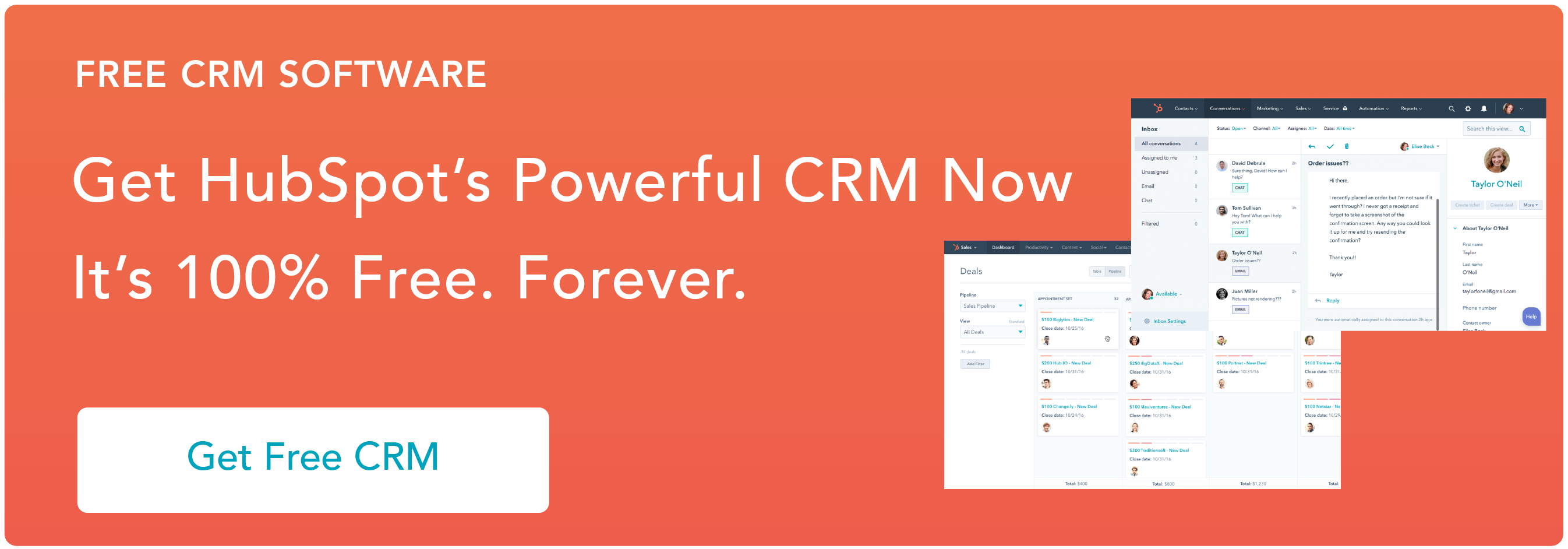Building Client Relationships
1. Communicate regularly.
Manage customer communications with HubSpot CRM
One of the most important ways to build relationships with customers is through regular communication. Whether it's sending email newsletters, making phone calls, or setting up a meeting or check-in, staying in touch with your customers shows that you value their business and are invested in their success.
Regular communication also provides an opportunity for you to update customers on new products, features, or promotions, ensuring they are aware of the value you provide.
2. Meet your customers where they are.
Bradley McKibben, a senior inbound consultant at HubSpot, says that you need to meet customers where they are in order to communicate and work most effectively with them.
“Do they live in their email inboxes, are they more on LinkedIn, are they research heavy and using Google a lot? Good communication has a lot to do with the channel you use,” McKibben explains.
Make it easy for customers to reach you, whether through phone, live chat, or email, and be responsive to their questions and concerns. Aim to provide efficient and effective resolutions to their issues, ensuring that they feel supported and valued throughout their experience with your company.
3. Practice active listening.
Building strong customer relationships involves active listening. When a customer reaches out with a question, concern, or feedback, it is essential to listen attentively, seek to understand their perspective, and empathize with their situation.
"Active listening is one of the most important skills in providing a great customer service experience," says Patrick Shelley, HubSpot Customer Success Manager. "In many instances, service professionals are quick to provide a solution without fully understanding the context and desired outcomes of the customer's unique situation."
Listening, and responding thoughtfully to a customer's needs shows that their opinion matters, and you're committed to finding a solution that meets their expectations.
4. Show what you know.
While active listening and thoughtful responses are key in building short-term relationships, customers can lose trust quickly if you don't keep this level of thoughtfulness consistent or forget critical details they've told you in past conversations.
To show that your customer has remained a top priority, take notes or use customer-relationship tools to keep track of pain points, feedback, and opportunities, as well as any personal anecdotes they've mentioned. While active listening helps the customer feel valued, remembering and mentioning something they've highlighted in past conversations can make them feel like they're your only client – even just for a moment.
5. Reward loyalty.
By acknowledging and appreciating your customers' continued support, you're reinforcing their decision to choose your brand over competitors. Loyalty programs that offer exclusive discounts, early access to new products, or personalized rewards create a sense of value and appreciation.
Take Starbucks Rewards, for example. By signing up for the program, you can earn points for each item you buy using the app which can be added up and used for a free item later, unlock freebies like free beverages on your birthday, and even get perks from Starbucks partners like Delta, earning one mile per dollar spent at the coffee franchise.

Late last year, the rewards program had generated significant revenue for the brand as members passed 28.7 million, up 16% year-over-year.
Even if you can't give out millions of dollars worth of coffee and flyer miles, simply providing personalized thank-you notes, perks, or milestone gifts can go a long way in strengthening the emotional connection with customers – while giving them more bang for their buck.
When customers feel valued and rewarded for their loyalty, they’re more likely to continue doing business with you and become brand advocates, spreading positive word-of-mouth recommendations.
6. Build a community.
“The more advocates you have, the fewer ads you have to buy,” says HubSpot CTO Dharmesh Shah.
In today's inbound-powered world, such wise words couldn't be truer. Ultimately, when people feel like they're part of something, they're more passionate about it, want to see it succeed, and – ideally – want to continue investing their money in the great experiences that come from it.
By fostering a sense of belonging, you not only strengthen relationships with individual customers but also create a network of advocates who can help promote your brand to a wider audience. This can also lead to deeper, longer-term relationships.
So how do you do it?
Encourage customers to connect with each other by hosting webinars, events, or forums where they can share insights, best practices, and success stories.
For example, Sephora, a beauty store with brick-and-mortar locations across the globe and a large virtual e-commerce store, offers a Beauty Insider community so people can share knowledge with each other.

Sephora's forum aims to unite its "beauty-obsessed" customers and "beauty newbies" who can virtually ask each other questions, join challenges, share looks, swap tips, try out new products, and connect with other like minded customers.
While those registered for an account within the community can post, reply, or share reviews as they please, those who aren't members – or have just stumbled upon Sephora's site for the first time – can still see most of the content and conversations.
Not only does this forum's membership perks retain customers by connecting them with other beauty-buffs, but it also enables them to help prospects learn about – and potentially buy – beauty products.
Say I am looking for a long lasting liquid lipstick that is non-drying. After a search, I might come across a thread where someone with a similar experience has gotten product recommendations directly from Sephora insiders:
From there, I might just make a purchase. And – because this community was so helpful – I might sign up to join when making my purchase.
How to Improve Customer Relationships
7. Gather Feedback.
Get feedback with HubSpot’s Customer Feedback Software
Soliciting customer feedback demonstrates that you value their opinions and want to improve your products or services. Regularly ask for their feedback through surveys, online reviews, or even a dedicated customer feedback portal.
Actively engage with this feedback by responding promptly, acknowledging their input, and taking steps to address any issues raised. By involving your customers in the improvement process, you make them feel like valued partners in your business.
8. Speed up response times.
As Christina Vuong, HubSpot Customer Success Manager puts it, "your customer's problem is now your problem." How quickly would you want them to respond if the tables were turned?
9. Streamline personalization.

Meet customers where they are with HubSpot's Introduction to Marketing Psychology
Customers appreciate when you take the time to personalize your interactions. This could be as simple as addressing them by name, remembering their preferences, sending personalized recommendations based on their past behaviors, or taking the time to get to know their needs.
“You need to put yourself in their shoes to understand what would be the most helpful and relevant content at that point in time for the persona you're targeting. It's not a great experience to receive unexpected emails or emails that don't make sense,” says McKibben.
But, if you have a growing pool of customers, personalizing everything and taking notes manually can take far too much time that could be used having productive, impactful conversations with customers.
You can also serve customers targeted emails and automated comms based on their interests, behaviors, and needs with tools like customized content and behavioral targeting.
By showing that you understand their unique needs and priorities, you create a sense of trust and loyalty.
10. Meet expectations. Then, crush them.
Once you improve your customer service relationship building to meet your client's expectations and standards, your work shouldn't stop there – especially if you want to stay competitive.
Whether you're just starting to benefit from improvements or hearing from more happy customers, take time to recognize what makes them happy and go the extra mile to get ahead of their needs, requests, and opportunities they haven't even recognized yet.
If you realize they like personalized experiences, surprise them with special discounts catered to them, new products or solutions that prevent pain points before they realize they have them, or just offering affordable freebies on birthdays or first-purchase anniversaries.
Showing that you're willing to go the extra mile and invest time – or revenue – toward their satisfaction not only increases customer loyalty but also encourages positive word-of-mouth.
Get Started With Building Customer Relationships
By implementing the strategies mentioned in this blog post — regular communication, personalization, active listening, going the extra mile, gathering feedback, offering support, and rewarding loyalty — you can create a foundation of trust, loyalty, and satisfaction with your customers.
These relationships not only lead to repeat business and increased customer retention but also generate positive word-of-mouth referrals and brand advocacy.
Building customer relationships is an ongoing process that requires consistent effort and commitment. By investing in building strong relationships, you are investing in the growth and sustainability of your business. Tools like HubSpot CRM can help you anchor these customer relationships.









![What Is Customer Goodwill? [Definition + Examples]](https://53.fs1.hubspotusercontent-na1.net/hubfs/53/Customer%20Goodwill.png)
